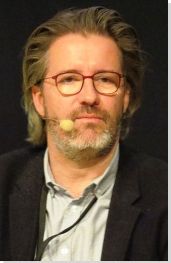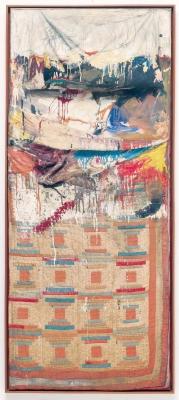Summary of Olafur Eliasson
A noted member of the Social Practice movement, Olafur Eliasson injects his work with a universal conscience that catapults art outside of its normal confines and challenges the way we inhabit the world. With each endeavor, he asks people to fully embody their human experience by expanding their feelings of self into a connection with the broader public sphere. His art is derived through a sincere practice in which he collaborates with experts in various fields to create diverse pieces intended to propose critical interventions within existing social systems, an effort that is designed to inspire debate and fresh perceptions, or to catalyze change. Eliasson has become a progressive leader in the kind of creative thinking that provokes the way people perceive culture, community, and the natural environment around them. Although his career has reached iconic status, Eliasson's core motivations set him apart from other superstars of the art world; whereas some artists of his stature are known for their superegos, altruism is the dominant trait in his reputation.
Accomplishments
- Eliasson's underlying mission to make the world a better place is largely informed by work that asks viewers to think about their role in globalization and environmentalism. In doing this, he expands the historical role of Activist art with a focus less on the personal issues of our time and more on the overreaching concerns that beg current contemplation toward a more humanitarian future.
- Eliasson strives to jostle the status quo by creating work that compels uncertainty, transforming the role of art beyond its simple aesthetic or experiential value and into a powerful tool for battling complacency. He has stated, "This uncertainty is important to me, as it encourages people to think and sense beyond the limits within which they are accustomed to function."
- The artist's presentation of our communal experience of space, ambiguous materialization, and its constant state of flux is often derived from the juxtaposition of manmade and ephemeral elements. His interactions with natural phenomena such as light, water, air, and the environment have vastly dissolved the boundaries of what is considered traditional artistic medium.
- Eliasson enforces his viewers to reconnect with the self, spurring reflection into their experiences within and relationship to the world at large. His work becomes a catalyst, which forwards the concept of individual agency.
Important Art by Olafur Eliasson
Beauty
Since the beginning of his career, Eliasson has endeavored to conceive visually impactful work with sincerity rather than irony. Completed while still a student at the Royal Danish Academy of Art, Beauty consists of a single spotlight illuminating a section of perforated tubing. When water is pumped through the tube, thousands of tiny water droplets cascade out, producing a curtain of mist, which then reflects the light to produce a rainbow. The sublime work both glorifies and dissects an environmental wonder, revealing Eliasson's unique ability to poetically interpret a scientific process.
Interaction with the natural environment along with perception, movement, and personal experience has always been a driving force in Eliasson's work. In this particular work, viewers are encouraged to move around and engage with the piece. In using their bodies to control their perspective, viewers manipulate a manmade ethereal phenomenon, and become responsible for their own dialogue with the work. Eliasson aims to heighten perceptual awareness, compelling individuals to become more connected to the space around them.
Spotlight, water, nozzles and hose - Museum of Contemporary Art, Los Angeles
Ventilator
Like Beauty before it, Eliasson's early works were typically sculptural structures built specifically for a space within a museum or gallery. Ventilator, his most celebrated early work, was a subtle kinetic sculpture first shown at the Museum of Modern Art in New York. The simple, hypnotic piece consisted of a fan, hung from an electric cord and propelled haphazardly around the room in concordance with the ambient air currents. Its mesmerizing movement, sometimes zooming over head while other times hovering indecisively, emphasized the grandness of the museum's atrium, while also calling attention to the emptiness of the space.
The physical and perceptual disruption the work created was achieved by Eliasson's scientifically inclined intellect. "You start to wonder what on Earth makes it fly," explained Eliasson. "When we walk into a space, we tend to look at the walls and the floor as solids, and everything between as somehow not there. We know very well that air is thick enough for a jumbo jet to take off and float on it. There is something there, conceptually, to solidify." As the fan propelled itself around the room, the desire to understand how it maneuvered reinforced the viewer's own awareness of their presence within the space. For Eliasson, connecting to the work and the space it inhabited promoted a connection with one's self. As curator and art historian, Madeleine Grynsztejn explains, "in this increasingly technological, digital era, art often separates us from our bodies, from our senses, from the world. Here is somebody who constantly refuses that, and who constantly returns us to a visceral, present-tense experience."
Altered fan, wire, and cable - The Museum of Modern Art, New York
Green river
In 1998, rather than reproducing natural phenomenon in an indoor setting, Eliasson began working with the environment directly. His first landscape intervention was Green river, a guerilla-style piece, in which he covertly changed the color of rivers in various cities by treating them with a harmless green dye used by biologists to track water currents. As Eliasson recalled, "what the green dye did, in my view, was it made people aware of their everyday surroundings in a new way - not just the river, which suddenly appeared different, but the town or landscape it was flowing through. We tend to see cities and spaces as static images, but in fact they are changing all the time. Sometimes it takes a radical shift to make us aware of this fact."
The radical visual effect of the dyed rivers lasted only a few hours, but it compelled viewers to reconnect with the urban spaces in which they lived. Unlike his previous sculptural work, which sought to inspire a relationship between participants and an irrelevant space; Green river sought to make a more meaningful connection between participants and the space they inhabit daily. The reaction to the dyed rivers varied from city to city, and in Los Angeles, where concrete viaducts mostly obstructed views of the river, hardly anyone noticed the change. While in Stockholm, Sweden, where the river flows through the center of the city, pedestrians were alarmed by the slime-colored hue and were convinced the city's water supply had been tainted.
Concerned they could incite panic, Eliasson abandoned these guerilla-art interventions in 2001. However, reimagining previous work is an integral part of Eliasson's artistic process, and in 2014 he fabricated a river to intervene with the space inside a museum. Riverbed, a site-specific installation for the Louisiana Museum of Modern Art in Denmark, blurred the boundaries between the natural world and the manmade one. The major intervention transformed the museum's gallery spaces into the rocky and rugged landscape of the Danish coast. A winding river flowed through the galleries, and as in nature, visitors were free to choose their own path as they explored the immersive environment. Through inviting visitors to take control of their experience, Riverbed eschewed the behavioral and intellectual conventions associated with museums.
Uranine and water - Moss, Norway
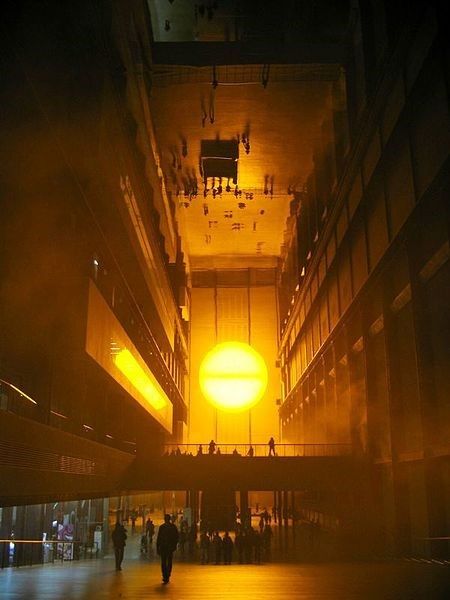
The weather project
Eliasson's ability to combine art, science, and natural phenomena to enhance the viewer's experience reached its apex when he began creating fully immersive installations on a grand scale. In his most celebrated large-scale installation, The weather project, Eliasson transformed the massive Turbine Hall at London's Tate Modern into a captivating artificial environment. Using a simple assemblage of 200 mono-frequency bulbs arranged in a semi circle and reflected onto a mirrored ceiling, Eliasson created a giant fake sun of dazzling pseudo-radiance. A misty fog that permeated the hall, accumulating into cloud-like formations before dissipating across the space, completed the alluring environmental effect. The ceiling of the space was covered by a large mirror in which visitors could see themselves as tiny black shadows on a sea of orange light. Many viewers of this exhibition were prone to lie on their backs and wave their hands and legs around in participation with the piece. And by bringing the sun indoors, people were encouraged to reconsider their relationship with an object of extraordinary beauty, which had otherwise become nonchalantly familiar. The awe-inspiring experience reportedly attracted two million visitors, evidence that Eliasson's mission to influence an individual's reconnection to the world around them was indeed successful.
While other artists would be criticized for pandering to the masses, Eliasson is praised and respected by critics and curators alike because of his intellectual rigor and integrity in regards to his work. When asked by the Tate to extend The weather project due to its popularity, the artist declined, fearful that the work would become a grotesque spectacle for the museum and himself. As Eliasson explains, "the media attention was very flattering, but it was also becoming very brutal. There was a danger that the project might slip from an artistic experience to mindless entertainment."
mono-frequency lights, projection foil, haze machines, mirror foil, aluminum, scaffolding - Collection of the Tate, United Kingdom
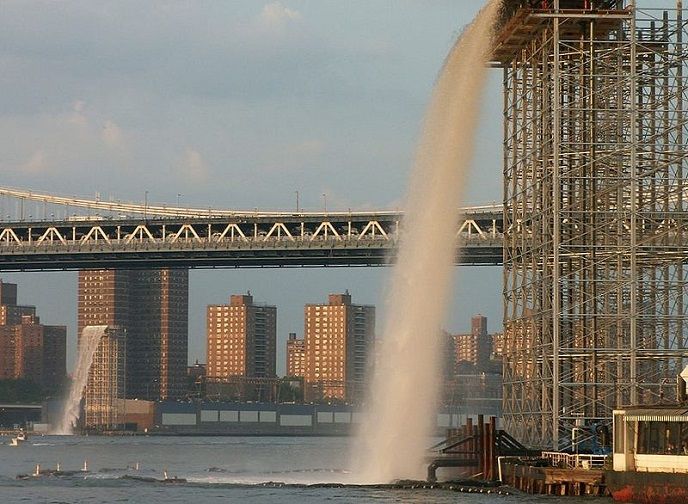
New York City Waterfalls
In 2008, Eliasson constructed his most popular work in the United States, The New York City Waterfalls. When he was commissioned by New York City's Public Art Fund to create large-scale installations in direct dialogue with the area, Eliasson aspired to build structures that would be a reaction to the immense size of the city. He chose to construct waterfalls, a soothing icon of natural phenomena, which could promote a sense of ever-present, peaceful measurement for a place whose gigantic size might be otherwise disorienting. Recounting his own experience in New York, Eliasson explains, "In a city like New York, I have some difficulty feeling my body, placing myself physically. Is that building nearby or is it far away?... So for me the waterfalls are a way of putting a sense of scale back into Manhattan."
The temporary installation consisted of four enormous mechanical waterfalls erected at specific sites along the East River. As the water fell into the river, the blowing wind revealed the structures' scaffolding. Seeing the mechanics generating the waterfalls was not only intentional, but just as integral to the work as the illusion of the natural phenomenon. "You always see the man behind the curtain in Olafur's work," explains Grynsztejn. "He shows you something that moves you to the core, and then he shows you how that happened. So you are a participant both ways - intellectually and just in terms of wonder." This also brought home Eliasson's point to viewers that they could be responsible participants in manipulating their own experience, conjuring thoughts of how one might act with agency within their world to create their own realities within any circumstance.
Water, scaffolding, steel grill age and troughs, pumps, piping, intake filter pool frames and filter fabric, LED lights, ultra-violet filters, concrete, switch gears, electrical equipment and wiring, control modules, and anemometers
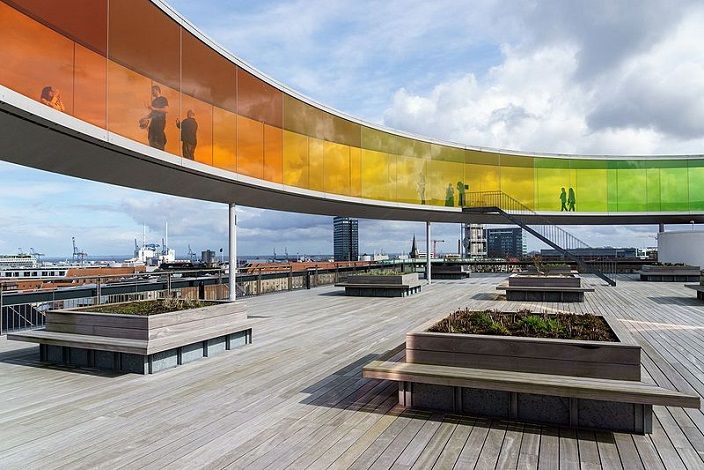
Your rainbow panorama
Eliasson's interest in immersive large-scale installations and fascination with structure and form naturally led his progression into architectural works, and Your rainbow panorama successfully blurs the lines between art and architecture. The piece is a permanent work set atop the ARoS Kunstmuseum in Denmark. Consisting of a circular walkway enclosed by multicolored transparent panels representing the full color spectrum, the large structure extends from one edge of the museum's façade to the other. The vivid rainbow hues invite visitors to walk around the structure, experiencing panoramic city views through the various tones. Slender columns holding up the structure make the static work seem as if it is floating above the building, further heightening the viewer's activity-driven experience. Eliasson said about the work, "I have created a space that can almost be said to erase the boundary between inside and outside - a place where you become a little uncertain as to whether you have stepped into a work of art or into part of the museum. This uncertainty is important to me, as it encourages people to think and sense beyond the limits within which they are accustomed to function."
With this work Eliasson also strives to enhance the viewer's experience by means of dramatic visual impact through a unique interpretation of light. In representing light by way of the color spectrum, he creates a space through which viewer's can see the city in an original way. His reason for doing so, as he explains, is because, "I am particularly interested in how the light of a space determines how we see that space and similarly, in how light and color are actually phenomena within us, within our own eyes."
Eliasson's fascination with light and color theory has led to a prolific subset of work exploring the subject, including One-way color tunnel, a site-specific sculpture in which participants walk through a kaleidoscope tunnel of triangular mirrors; and Turner color experiment, in which Eliasson created large color wheel paintings isolating the exact pigments famous 18th century landscape painter J.M.W. Turner used in his paintings.
glazed rainbow-colored glass, steel - ARoS Kunstmuseum, Aarhus, Denmark
Little Sun
At the beginning of the 21st century, when artists were becoming more aware of globalization's negative implications, Eliasson began seeing his art as a tool to counteract the consequences of a globalized society. He has stated that, "art is not just an object, it is a sense of community."
In this seminal project Little Sun, Eliasson worked with engineer Fredrick Otteson to develop a small, solar LED lamp shaped like a meskel flower - Ethiopia's symbol for positivity and beauty. The portable and affordable suns were devised to provide the 1.2 billion people worldwide living without electricity a clean and accessible light source as an alternative to the more often used toxic, fuel-based kerosene lanterns.
In conceiving the Little Suns, Eliasson created not only a useful work of art, but also a humanitarian one. When a Little Sun is sold within a country that has electricity, another one is automatically provided to an off-grid African community at a locally affordable price. By setting up a distribution system that connects disparate regions, Eliasson has turned art into a social business. His team encourages off-grid entrepreneurs to start their own small businesses selling Little Suns by providing them with starter kits and training. As a result, the suns create jobs and generate profits within local communities. In creating art to assist impoverished communities, Eliasson, along with other likeminded artists, is at the forefront of the Social Practice movement, which is transforming what it means to be an artist today for the cause of greater good.
high-grade polycarbonate plastic, solar panel, LED, and rechargeable battery
Ice watch
Eliasson's work often explores the relationship between humans and the natural world, and as his artistic practice has continued to veer toward the altruistic, he has become more concerned with mankind's impact on climate. Ice Watch is a recent work in which the artist called attention to a global environmental crisis with the hope of spurring the concepts of personal responsibility and positive change in viewers. With the assistance of longtime collaborator and geologist, Minik Rosing, Eliasson transported 100 tons of ice from a fjord in Greenland to Copenhagen's city square. The twelve blocks of ice were displayed in the formation of a clock, serving as a physical count down to rising global temperatures and sea levels. As the large ice blocks stoically sat melting, visitors were encouraged to touch them and feel the physical reality of time passing alongside climate change. Eliasson said the piece allowed for the ability to "reach people in a way that reports, graphs, and data cannot." He concluded, "I feel that this is an important step towards motivating people not just to know something but also to respond to it, to feel the urgency of it and to take action."
In an effort to transform feeling into action, Ice watch has become an ongoing project, having already been installed a second time at the Place du Panthéon, Paris in 2015 during the United Nation's Climate Conference.
12 Greenlandic inland ice blocks - Copenhagen City Hall Square
Glacial rock flower garden
In 2016, Eliasson was invited to create a site-specific installation at the Chateau de Versailles. He took the opportunity to further his Social Practice's spotlight onto climate change by including a triptych of water-related projects on the palace grounds.
The most seminal piece was Waterfall, in which an immense stream of water fell from a construction crane, constructed of yellow steel to emulate the gold in the nearby Apollo's garden. As in his New York waterfall works, the viewer witnessed not only the gorgeous waterfall, but also the machinations of man, which created it. It provoked reflection on our human impetus to use and manipulate natural resources for the pleasure of our egos. Another piece, Glacial rock flour garden, consisted of 150 tons of granite rock imported from Greenland, which had been ground down by glacial erosion. It was laid down around a statue of Persephone, the goddess of spring, to invoke reflection on the loss of nature. As visitors strolled through the gardens, they also experienced Fog assembly, an ethereal emission of white mist clouds, which lent an eerie, unsettling feel to the experience.
Inside the Chateau, Eliasson installed several space interventions using mirrors and light all designed to jostle a person's sense of reality. The curious museum (2010) was comprised of mirrors behind the windows of the Hercules Room, which reflected arches back at the viewer. In Your sense of unity (2016) visitors stood at the end of the Hall of Mirrors and looked into a reflective triangle bisected by a semi-circle, which created a perpetual pane of illuminated circles. In Solar compression (2016), a rotating, suspended mirror that was edged with orange light reflected the marquetry on the wooden floorboards and fireplace of the King's Guards' Room. Lastly, The gaze of Versailles (2016), was a simple pair of gold balls, a metaphor for eyeglasses, which sat on the windowpane in the Lower Gallery looking out over the gardens.
Eliasson accomplished the task of simultaneously respecting the heritage of Versailles and creating works that led viewers to contemplate issues of man's relationship to, and use of, the natural world. About this project he has said, "The Versailles that I have been dreaming up is a place that empowers everyone. It invites visitors to take control of the authorship of their experience instead of simply consuming and being dazzled by the grandeur. It asks them to exercise their senses, to embrace the unexpected, to drift through the gardens, and to feel the landscape take shape through their movement."
Although other artists such as Anish Kapoor and Jeff Koons also created site-specific installations for Versailles that bristled the hairs of more traditionalist audiences, Eliasson as the ninth artist commissioned for the deed, was highly praised for his atmospheric works that cohered seamlessly into the architecture and the grounds.
150 tons imported granite rock - Chateau de Versailles
Biography of Olafur Eliasson
Childhood
Olafur Eliasson was born in Copenhagen, Denmark in 1967, a year after his 21-year-old parents, Elías Hjörleifsson and Ingibjörg Olafsdottir, immigrated to the city from Iceland. His mother, who was from an Icelandic fishing village dating back to the 11th century, found work as a dressmaker, while his father, who was an amateur artist, found work as a cook on a fishing boat. His father's family was from Reykjavík, Iceland's capital, where they were part of a small artistic community. Eliasson's grandmother was a photographer and his grandfather, who abandoned his family when Elías was young, was a publisher of avant-garde literature. Eliasson's own parents, who were young and inexperienced, divorced when he was four. Elías, following in his own father's footsteps, moved back to Iceland, leaving a young Olafur fatherless throughout much of his childhood and adolescence. During his infrequent trips to visit his father, Eliasson began making drawings as a way to impress him. By the time he was 14 he could draw every bone in the human body, and at 15, he had his first art show - displaying several landscape paintings at an alternative art space in Denmark.
As a teenager, Eliasson displayed a natural aptitude for art, but had no real aspirations to become an artist. Instead, he spent most of his time breakdancing after discovering the dance form on an American television show. "We lived in the countryside at the time, on a little farm, and I remember that for months and months I just moved around like a robot. In the beginning I was really bad at it," recalled Eliasson. "It must've been funny to see me moving around the cows and horses... I'm sure I was the only robotic electric boogie dancer with eyeliner." After forming the "Harlem Gun Crew" with two friends, the group, dressed in silver spandex made by Eliasson's mother, would perform at clubs around Copenhagen and competed internationally, eventually winning the Scandinavian breakdancing championship twice.
Early Training
1987 would become a turning point in Eliasson's life. During the tumultuous year, his grandfather killed himself and his father was hospitalized for alcoholism, requiring Olafur to move to Iceland in order to care for his two-year-old half sister, Anna Viktoria. Out of mere boredom, Eliasson decided to apply to art school, and was duly accepted to the prestigious Royal Danish Academy of Art. "I would be lying if I said there wasn't an element of escapism in my interest in art as a teenager," he said. "Making no sense seemed more attractive to me than making sense. Applying to art school was a lovely way for me to disconnect. Once I got there, though, I realized that art is about connecting. Instead of stepping out of the world, I was stepping right into the heart of it. This was a revelation for me. I thought it was only about being a good artist so that my father would like me. But it was more about shaping the world."
This notion of art as being a crucial means for turning thinking into doing within the world would lay the foundation for Eliasson's eventual foray into Social Practice, an art medium focused on engagement through human interaction and social discourse.
During his time at the art academy Eliasson was given a travel budget, and in 1990 he moved to Brooklyn, New York where he worked for a period as a studio assistant for the minimalist painter, Christian Eckart. During this time he also became a voracious reader and immersed himself in philosophy and scientific theories. He became especially intrigued with natural science and phenomenological philosophy, and its emphasis on an individual's experience of reality. How a person interprets reality would become a consistent niche for Eliasson's work.
Mature Period
Shortly after graduation from art school in 1995, Eliasson's ephemeral sculptures, which poignantly articulated natural phenomenon, were being exhibited in galleries and museums around the world. At the same time he was finding international success, Eliasson also reconnected with his father, who had recovered from his illness. Elías would even sometimes cook for his son's gallery openings, and this relationship continued until Elías's death in 2002 from pulmonary fibrosis.
In 1995, Eliasson established Studio Olafur Eliasson in Berlin with an emphasis on collaboration. Founded as a "laboratory for spatial research," it would become a space to engage with architects, engineers, craftsman, and assistants to conceive and construct large-scale projects, installations, and sculpture that embodied Eliasson's interests in perception, movement, experience, and feelings of self within both the manmade and natural worlds.
For example, in 1996 Eliasson started working with architect and geometry expert Einar Thorsteinn to create pieces such as 8900054, a 30-foot wide and seven-foot high stainless steel dome that appeared to be growing directly from the ground. The piece caused viewers to reflect upon things that are in constant development deep beneath ordinary surfaces.
In 1997 Eliasson was asked to contribute to the Danish pavilion at the São Paulo Biennial where he met Danish art historian and pavilion curator Marianne Krogh Jensen. The two connected over an altruistic desire to help those less fortunate. After marrying in 2003 they adopted two children from Ethiopia - a son in 2003 and a daughter in 2006.
Starting in the early 2000s and with the help of his innovative studio collaborators, Eliasson began thinking of his socially engaged art as a means to affect change on a global scale. From 2009 to 2014, he imparted these philosophies as a professor at the Berlin University of the Arts. In 2012, he created Little Suns, portable solar lamps, which allow impoverished communities without access to electricity the ability to see in the dark. He also used proceeds from the sale of his art to establish, along with his wife, 121Ethiopia, a foundation that funds African orphanages.
A global artist concerned with the welfare of the world, today Eliasson travels the globe discussing how art can have a positive impact on humanity's future. And while Eliasson's art takes him all over the world, he often brings his family along in his travels, determined not to make the same mistakes his own father made with him.
In 2014, along with architect Sebastian Behmann, Eliasson established an architectural counterpoint to Studio Olafur Eliasson called Studio Other Spaces, which focuses on interdisciplinary and experimental building projects and works in public spaces.
Today, Eliasson commutes between Copenhagen, where his family resides, and his studios in Berlin. With over 80 employees, the studio now functions more like a laboratory, where experimentation and exploration into many arenas including science, architecture, geometry, space, the environment, and natural phenomena combine to inform the creation of participatory art for individuals, institutions, and communities.
The Legacy of Olafur Eliasson
In striving to make art concerned with the issues of society at large, Eliasson's artistic practice, along with fellow socially engaged artists, Ai Weiwei, Thomas Hirschhorn, and Theaster Gates, helped form the Social Practice movement. Like the earlier Relational Aesthetics artists, these works take human relations and social discourse as their starting point. Yet, unlike the slightly earlier generation, rather than produce work for art institutions, these artists aim to generate social change by means of collaboration and through the creation of participatory art outside of the gallery system.
Reimagining art's role within a global society, Eliasson utilizes his art for causes that were once the domain of activists and environmentalists. Like other Social Practice artists, Eliasson now demands that art have a social conscience. "Nowadays, art has great potential for changing the world and improving people's lives," he explains. "Partly because it can nurture a degree of trust... And it can bring about not only the potential for feeling, but also for acting."
Influences and Connections

-
![Robert Rauschenberg]() Robert Rauschenberg
Robert Rauschenberg -
![James Turrell]() James Turrell
James Turrell -
![Bruce Nauman]() Bruce Nauman
Bruce Nauman ![Gordon Matta-Clark]() Gordon Matta-Clark
Gordon Matta-Clark
-
![Hans Haacke]() Hans Haacke
Hans Haacke ![Robert Irwin]() Robert Irwin
Robert Irwin
- Bill Gates
- Kofi Annan
- Hans Ulrich Obrist
-
![Environmental Art]() Environmental Art
Environmental Art -
![Installation Art]() Installation Art
Installation Art - Social Practice
Useful Resources on Olafur Eliasson
- Unspoken Spaces by Olafur Eliasson
- Olafur Eliasson: Contact by Olafur Eliasson
- Olafur Eliasson: Werke/Work 1994 -2015
 Ask The Art Story AI
Ask The Art Story AI